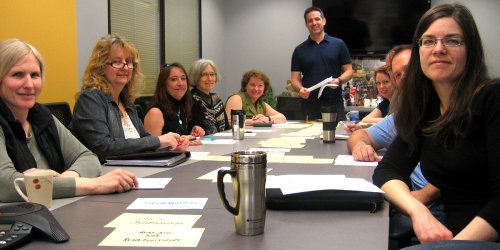 Serving as mayor provides one with an array of opportunities to demean oneself on a regular basis—funny hats and dunk tanks tend to be involved. However, for me, and for most of the mayors I know, the lowest moments occur in the grandest corporate offices during economic development ‘recruitment’ trips. After schlepping the best and brightest ambassadors from our city to visit the target company, a mayor is given 30 minutes to make their pitch that the company will be happier, more productive, and profitable in their community. A PowerPoint presentation is given focusing on the quality of the schools, the vibrant culture, the ready and able workforce and, of course, how the city is “business friendly.” The mayor wraps up with an impassioned entreaty that a good community could be made great if that company would move their offices to town.
Serving as mayor provides one with an array of opportunities to demean oneself on a regular basis—funny hats and dunk tanks tend to be involved. However, for me, and for most of the mayors I know, the lowest moments occur in the grandest corporate offices during economic development ‘recruitment’ trips. After schlepping the best and brightest ambassadors from our city to visit the target company, a mayor is given 30 minutes to make their pitch that the company will be happier, more productive, and profitable in their community. A PowerPoint presentation is given focusing on the quality of the schools, the vibrant culture, the ready and able workforce and, of course, how the city is “business friendly.” The mayor wraps up with an impassioned entreaty that a good community could be made great if that company would move their offices to town.
The company’s senior vice president of real estate then offers his thanks and notes that your hometown is indeed a wonderful place, but is deficient in the following ways: access to transportation, high cost of housing, proximity to suppliers, or some combination thereof. He then notes that another city, which happens to possess all of these necessary attributes, was just in last week. They have offered a very attractive package of tax breaks and public investments that this mayor would need to beat in order to stay competitive.
Now that the competition and egos between mayors (who are by definition hypercompetitive) are properly stoked, a bidding war ensues and good economic analysis and public policy quickly fall by the wayside. In the end, the company moves to the community it was probably going to move to anyway, but with a generous combination of tax breaks and subsidies that justify the senior Vice President’s salary.
For a generation, Michael Shuman has been a lonely voice arguing against these kinds of deals. In an attempt to bring reason and thoughtfulness to the politics of economic development, he has focused on commonsense economics. His new book, The Local Economy Solution: How Innovative, Self-Financing “Pollinator” Enterprises can Grow Jobs and Prosperity (Chelsea Green, 2015) reiterates the core arguments of his previous works: first, most businesses in the United States are local. Second, local businesses are engines of growth and much more likely to create jobs than large companies. So, cities and states should stop trying to lure huge corporations from one jurisdiction to another and should instead invest in the local businesses that are likely to stay, create jobs, and support the local economy. Shuman was local before local was cool.
Shuman effectively highlights the madness of the traditional and expensive economic development approach. He starts with Maryland paying the producers of the Netflix series House of Cards USD $26 million to film the show in Annapolis, even though the city is disguised as Washington, DC. The filming creates 5,900 mostly part-time jobs, which means that the state is paying USD $4,400 per position per year in the best-case scenario, because not all the jobs go to Marylanders who are underwriting this bill with their tax dollars.
Maryland looks good in comparison to some of the other jurisdictions highlighted by Shuman. Sarasota, Florida offered a Danish pharmaceutical company USD $137 million in incentives to create a mere 191 jobs— and lost to a county in North Carolina. As Shuman points out, USD $137 million invested in bonds at five percent would generate USD $38,000 annually in perpetuity for every Sarasotian.
These examples are shocking, but it is the aggregate impact that is the most troubling. As governments spend billions to steal businesses from one locality to another, Shuman’s point becomes very clear: “Economic development today is creating almost no jobs whatsoever…[and it] constitute[s] a net drag on the economy.” Thankfully, his solution to invest more locally is gaining traction with policymakers, even as some high profile governors—now Presidential candidates—continue to buy commercials in other states offering relocation services.

Shuman argues that cities should abandon large corporations in favor of investing in local businesses and fueling local economies. In Ann Arbor, Michigan, the city leverages community and cultural events to boost local businesses
Unfortunately, investing locally is easier said than done. Economies have grown more complex and globalized. Is it better to buy a table made in Malaysia from your local furniture store or from an Etsy artisan 500 miles away? How does, or how should, a community support a business that exports its products globally? Should we consider the nearby publicly traded company part of the local economy, or part of theWall Street economy?
Shuman attempts to create a framework for these kinds of decisions through his six “Ps” of local economic development : Planning (understanding opportunities for local businesses to meet local needs); Purchasing (buy local); People (training local entrepreneurs and employees); Partnership (collaborations of local businesses); Purse (mobilizing local capital); and Public Policy (leveling the regulatory playing field for local businesses).
From his years consulting with communities and working with and for BALLE (the Business Alliance for Local Living Economies), Shuman offers some interesting direction for these local efforts: they must be self-sustaining and not reliant on grants and goodwill. This is an important point that he reiterates throughout the book, but it also makes for dispiriting reading: a job creator in Appalachia is creating hundreds of jobs at a cost of just USD $500, only to see his funding run out: a successful local coupon book loses popularity; an innovative government administrator tires of fighting with his Chamber of Commerce and takes a job at a public market.
One must give Shuman credit for pointing out the realities of local economies—they are unique, messy, and reliant on a few key leaders, which is not a good combination when competing against relentless and focused mega-corporations and their lobbyists. However, Shuman offers dozens of potential solutions, such as youth entrepreneurship schools, local debit cards, maker spaces, and coordinated local farmer delivery services. With all of these possible solutions, a community should be able to find a strategy or two that will move the needle.
Small is (or at least has the potential to be) big. Shuman quotes an innovative Melbourne-based developer who argues, “Economic development needs a paradigm shift. It needs to embrace deeper democracy, deeper engagement. It’s not just about economics of money, but cultural economics and human economics. It should be a transformative process, connecting head, heart and hand…we can’t forget the joy and celebration.”
Richard Florida, an economist and best-selling author, has similarly argued that, “For perhaps the first time in human history, the further progress of our economy is inextricably tied up with the further development of our essential humanity.” This is no easy task. Shuman has proven that our current approach is damaging to both our economy and to humanity. With hundreds of cities and local businesses charting their own path and experimenting with how to align capital and community values, perhaps there is some hope for vibrant local economies and maybe even for mayors limiting their public humiliation to silly hats instead of the costly service of corporate greed.
Originally published in The Solutions Journal, Volume 6, Issue 4 (November 2015)
 Ryan Coonerty is a Supervisor for Santa Cruz County in California and a two-time former Mayor of the City of Santa Cruz. He is the cofounder of NextSpace Coworking + Innovation, a lecturer on law and government at UC Santa Cruz, and co-author of The Rise of the Naked Economy – How to Benefit from the Changing Workplace (Macmillan, 2013). He also wrote Etched in Stone – Enduring Words from our National Monuments (National Geographic, 2007). Ryan was selected by the Aspen Institute to be a Rodel Fellow in Public Leadership as one of “the nation’s most promising young elected officials.”
Ryan Coonerty is a Supervisor for Santa Cruz County in California and a two-time former Mayor of the City of Santa Cruz. He is the cofounder of NextSpace Coworking + Innovation, a lecturer on law and government at UC Santa Cruz, and co-author of The Rise of the Naked Economy – How to Benefit from the Changing Workplace (Macmillan, 2013). He also wrote Etched in Stone – Enduring Words from our National Monuments (National Geographic, 2007). Ryan was selected by the Aspen Institute to be a Rodel Fellow in Public Leadership as one of “the nation’s most promising young elected officials.”
 Congratulations to Aki Energy, a member of CCEDNet Manitoba for receiving the Province of Manitoba’s 2015 Manitoba Excellence in Sustainability Awards!
Congratulations to Aki Energy, a member of CCEDNet Manitoba for receiving the Province of Manitoba’s 2015 Manitoba Excellence in Sustainability Awards!

 The Canadian Alternative Investment
The Canadian Alternative Investment The federal government has released an open invitation for pre-budget submissions from Canadians in advance of the 2016 Federal Budget. The government has not set a date for the finalized budget but it will likely be published before the end of the fiscal year (March 31).
The federal government has released an open invitation for pre-budget submissions from Canadians in advance of the 2016 Federal Budget. The government has not set a date for the finalized budget but it will likely be published before the end of the fiscal year (March 31). Like many major metropolitan areas in the United States, Toronto is experiencing fast-paced growth. Canada’s finance and business capital has more cranes in the sky than New York City—with nearly 50 percent more high-rises undergoing construction than in the big apple. Between 1990 and 2012, the region experienced a doubling of the economy, and significant population growth. By 2013, Toronto had become the fourth largest city in North America and today, almost one fifth of all Canadians live in the metropolitan area.
Like many major metropolitan areas in the United States, Toronto is experiencing fast-paced growth. Canada’s finance and business capital has more cranes in the sky than New York City—with nearly 50 percent more high-rises undergoing construction than in the big apple. Between 1990 and 2012, the region experienced a doubling of the economy, and significant population growth. By 2013, Toronto had become the fourth largest city in North America and today, almost one fifth of all Canadians live in the metropolitan area.  Amidst such frenzied development and economic growth, however, many have been resigned to the margins:
Amidst such frenzied development and economic growth, however, many have been resigned to the margins:

 Michelle Stearn began working at the Democracy Collaborative as a Communications Associate in Fall 2015 after graduating from Georgetown University with a Bachelor’s degree at the School of Foreign Service. Her studies focussed on environmental justice, globalization, and critical theory. She also studied sustainable community development and urban agronomy for a semester in Santiago, Chile, where her Spanish accent became quite distinctive.
Michelle Stearn began working at the Democracy Collaborative as a Communications Associate in Fall 2015 after graduating from Georgetown University with a Bachelor’s degree at the School of Foreign Service. Her studies focussed on environmental justice, globalization, and critical theory. She also studied sustainable community development and urban agronomy for a semester in Santiago, Chile, where her Spanish accent became quite distinctive. Violeta Duncan began working for the Democracy Collaborative as an Associate, Community Wealth Building Research & Strategy in May of 2014. She received her undergraduate degree from Washington University in St. Louis and her master’s degree in urban planning from Columbia University, where she concentrated on participatory planning and local procurement practices in Kenya. Duncan assists in the production of the monthly Community-Wealth.org newsletter and maintains the Community-Wealth.org blog, in addition to supporting feasibility studies and other community wealth building research.
Violeta Duncan began working for the Democracy Collaborative as an Associate, Community Wealth Building Research & Strategy in May of 2014. She received her undergraduate degree from Washington University in St. Louis and her master’s degree in urban planning from Columbia University, where she concentrated on participatory planning and local procurement practices in Kenya. Duncan assists in the production of the monthly Community-Wealth.org newsletter and maintains the Community-Wealth.org blog, in addition to supporting feasibility studies and other community wealth building research.


 In his recent
In his recent  In 2016, LITE will award Community Economic Development Grants in the month of June. Grant recipients will be notified in May.
In 2016, LITE will award Community Economic Development Grants in the month of June. Grant recipients will be notified in May.
 Cities offer the scale needed for transformative change — large enough to matter, but small enough to manage. Universities and colleges are also civic actors in their own right. They are “cities within cities,” where the principles of pluralism create communities of diversity, open to the world. The relationship between post-secondary institutions and cities can serve as an engine of social and environmental sustainability. As part of its pursuit of a more inclusive, sustainable, and resilient society, the J.W. McConnell Family Foundation has created RECODE, an initiative dedicated to catalyzing social innovation and entrepreneurship in higher education; and Cities for People, which contributes to more resilient, livable and inclusive cities.
Cities offer the scale needed for transformative change — large enough to matter, but small enough to manage. Universities and colleges are also civic actors in their own right. They are “cities within cities,” where the principles of pluralism create communities of diversity, open to the world. The relationship between post-secondary institutions and cities can serve as an engine of social and environmental sustainability. As part of its pursuit of a more inclusive, sustainable, and resilient society, the J.W. McConnell Family Foundation has created RECODE, an initiative dedicated to catalyzing social innovation and entrepreneurship in higher education; and Cities for People, which contributes to more resilient, livable and inclusive cities. Poverty reduction has no silver bullet. Nor should we expect one. The exhausting and overwhelming work of reducing poverty must take a comprehensive, long-term approach that is led by the communities in need. These communities, who struggle against poverty and social exclusion every day, have repeatedly said this work requires more than a simple transfer of money.
Poverty reduction has no silver bullet. Nor should we expect one. The exhausting and overwhelming work of reducing poverty must take a comprehensive, long-term approach that is led by the communities in need. These communities, who struggle against poverty and social exclusion every day, have repeatedly said this work requires more than a simple transfer of money. Blog by: Darcy Penner
Blog by: Darcy Penner





 Ryan Coonerty is a Supervisor for Santa Cruz County in California and a two-time former Mayor of the City of Santa Cruz. He is the cofounder of NextSpace Coworking + Innovation, a lecturer on law and government at UC Santa Cruz, and co-author of The Rise of the Naked Economy – How to Benefit from the Changing Workplace (Macmillan, 2013). He also wrote Etched in Stone – Enduring Words from our National Monuments (National Geographic, 2007). Ryan was selected by the Aspen Institute to be a Rodel Fellow in Public Leadership as one of “the nation’s most promising young elected officials.”
Ryan Coonerty is a Supervisor for Santa Cruz County in California and a two-time former Mayor of the City of Santa Cruz. He is the cofounder of NextSpace Coworking + Innovation, a lecturer on law and government at UC Santa Cruz, and co-author of The Rise of the Naked Economy – How to Benefit from the Changing Workplace (Macmillan, 2013). He also wrote Etched in Stone – Enduring Words from our National Monuments (National Geographic, 2007). Ryan was selected by the Aspen Institute to be a Rodel Fellow in Public Leadership as one of “the nation’s most promising young elected officials.”